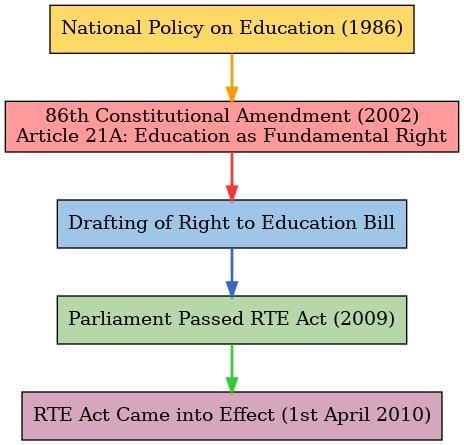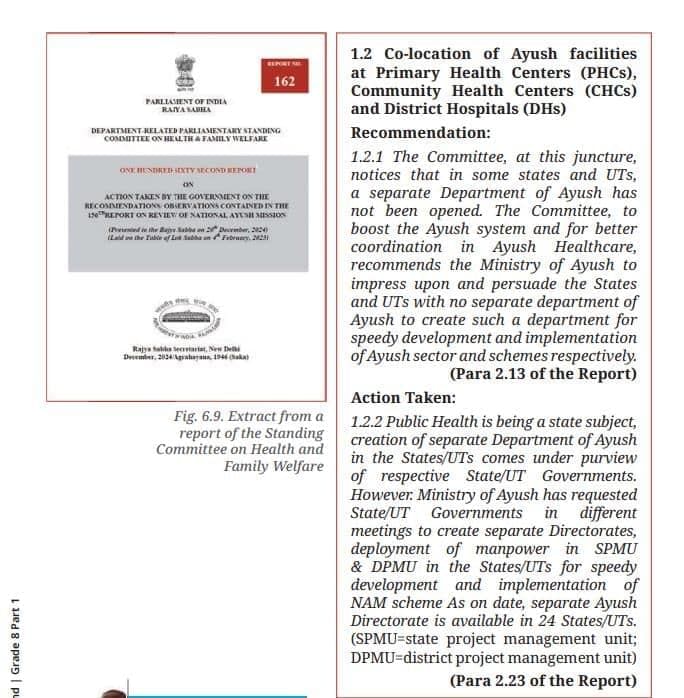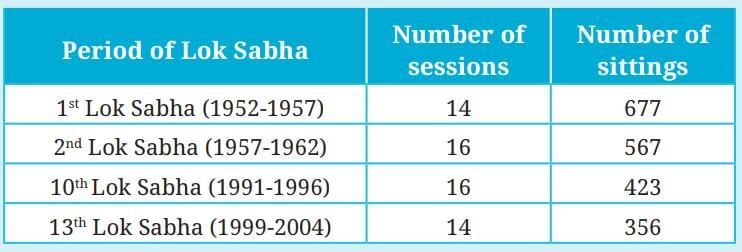Let's Explore: The Parliamentary System: Legislature and Executive | Social Science Class 8 - New NCERT PDF Download
Page 145: LET’S REMEMBER
From your previous lessons on the theme of Democracy and Governance, name a few Constitutional functions of the Parliament. Did you list the election of President and Vice President? What about amendments to the Constitution? Indeed, these are vital constitutional functions of the Parliament. There are other important functions that we will explore in higher grades.
- Some constitutional functions of Parliament are making laws, amending the Constitution, ensuring federalism, and upholding Fundamental Rights. It also takes part in the election of the President and Vice President.
- These functions ensure balance of power and strengthen democracy.
Page 145: LET’S EXPLORE
Draw a small chart to show the process of how RTE became an act. What do you think the process would be if RTE had been tabled in the Lok Sabha?
- For RTE (tabled in Rajya Sabha):

- If tabled in Lok Sabha first: Same steps, but start in Lok Sabha, then to Rajya Sabha for review, back if changes, then President.
Page 150: LET’S EXPLORE
Given here is an extract from the report of meetings between the Standing Committee on Health and Family Welfare and the officers from the Ministry of Health and Family Welfare. 
Q: Who is reporting to whom?
The Standing Committee on Health and Family Welfare is reporting to the Parliament.
The Ministry of Ayush (officers) is replying to the Committee’s recommendations.
Q: What is the subject that has been reviewed?
The subject under review is the co-location of Ayush facilities at Primary Health Centers (PHCs), Community Health Centers (CHCs), and District Hospitals (DHs) and the need for a separate Department of Ayush in all States/UTs.
Q: Identify the Committee’s recommendation.
The Committee recommended that States and UTs which do not have a separate Department of Ayush should create one.
This would ensure better coordination, boost the Ayush healthcare system, and allow speedy development and implementation of Ayush schemes.
Q: What is the government’s reply?
The Ministry of Ayush replied that since Public Health is a state subject, the creation of a separate Ayush Department depends on the respective State/UT governments.
However, the Ministry has requested States/UTs in various meetings to create separate Directorates and deploy manpower at state and district levels for speedy development.
As of now, 24 States/UTs have already created separate Ayush Directorates.
Page 151: LET’S EXPLORE
Why do you think that Parliament keeps an eye on government expenditure? (Hint: Whose money does the government spend?)
- Parliament watches spending because it's the people's money from taxes!
- They approve budgets to ensure funds help schools, roads, and health, not waste.
- This stops misuse, like checking if money for education really builds schools. It keeps government honest and fair for everyone!
Page 151: DON’T MISS OUT
Part V of the Indian Constitution begins with Chapter I — The Executive. It looks at the roles and responsibilities of the President, Vice President, and Council of Ministers, among others. It is in Chapter II that the role and functions of Parliament are listed. Why might this be so?
Ans: The Constitution is arranged in a logical order. First, in Part V, Chapter I, it talks about The Executive – the President, Vice President, Prime Minister, and Council of Ministers. This is because the Executive is responsible for carrying out laws and running the government.
Then, in Chapter II, it explains the Parliament, which is the law-making body. The Parliament makes the laws, and the Executive implements them.
So, the reason Parliament’s role comes after the Executive’s is to show the balance of power:
- The Executive governs according to the Constitution.
- The Parliament makes laws that guide the Executive’s work.
Page 152: LET’S EXPLORE
If the Executive is part of the Legislature, how do we say that there is separation of power? (Hint: revisit the section on legislature above)
- Even if ministers are MPs, separation exists because Legislature makes laws, Executive implements, but Legislature questions Executive through debates and committees.
- Like Question Hour holds ministers accountable! In discussion, we'd say checks like no-confidence votes ensure Executive doesn't overstep, keeping balance.
Page 154 and 155: LET’S EXPLORE
Q1. What might happen if one of the organs — Legislature, Executive, Judiciary — had all the power? How could it affect the rights of people? Discuss with your classmates how each organ checks the others. For example, how does the Legislature question the actions of the Executive? How does the Judiciary make sure that laws and government actions respect the Constitution? Do you think there might be ways in which the actions of the Judiciary itself are reviewed?
- If one organ had all power, like Executive, it could ignore rights, leading to unfair laws or arrests without trial—people lose freedom! Legislature checks Executive via questions and votes.
- Judiciary reviews laws for Constitution fit, striking down bad ones.
- Yes, Judiciary reviewed by higher courts or Parliament amending laws. In group, we'd say this balance protects us, like Supreme Court checking emergency powers!
Q2. Can you find examples where the Judiciary has asked lawmakers to review a law? Can you find any instances when the implementation of a law has been questioned by the Judiciary?
- Judiciary asked review in Kesavananda Bharati case (1973), limiting Parliament's amendment power to protect Constitution's basic structure. In Puttaswamy case (2018), Aadhaar law reviewed for privacy rights.
- For implementation, in Vishaka case (1997), Judiciary questioned lack of sexual harassment laws, creating guidelines till Parliament acted. In 2023, same-sex marriage petitions questioned implementation of equality laws. These show Judiciary pushes fair application!
Page 157: LET’S EXPLORE
What type of legislature does your state have?
Ans:
- Unicameral Legislature → Only one House (Legislative Assembly / Vidhan Sabha). Most states, like Rajasthan, Haryana, Punjab, etc., have a unicameral legislature.
- Bicameral Legislature → Two Houses (Legislative Assembly + Legislative Council / Vidhan Sabha + Vidhan Parishad). A few states, like Uttar Pradesh, Bihar, Maharashtra, Karnataka, Andhra Pradesh, and Telangana, have a bicameral legislature.
Page 158: LET’S EXPLORE
Q1. Study the data given in the following table. What conclusions can you draw about the functioning of Parliament over time? Compile data for more recent years.
From the data, we can see that over time, the number of sittings of Parliament has decreased:
The 1st Lok Sabha (1952–1957) had the highest sittings (677) and more sessions (14).
By the 2nd Lok Sabha (1957–1962), sittings had already reduced to 567, though the number of sessions increased to 16.
In later years, such as the 10th Lok Sabha (1991–1996) and 13th Lok Sabha (1999–2004), the sittings declined further to 423 and 356 respectively, even though the number of sessions remained between 14–16.
This shows a steady decline in the number of days Parliament actually works, meaning less time is spent on debates, law-making, and holding the government accountable.
If we look at more recent years (15th and 16th Lok Sabha), studies show that this trend of fewer sittings continues, raising concerns about the effectiveness of parliamentary functioning in a democracy.
Q2. Read the following statement of the former chairman of the Rajya Sabha, M. Venkaiah Naidu given in 2021: “...the productivity of Rajya Sabha during 2004-14 has been about 78% and it declined to about 65% since then. Of the 11 sessions [that he presided over], four of them clocked low productivity of 6.80%, 27.30%, 28.90% and 29.55%; during the year 2018, the Rajya Sabha recorded the lowest ever productivity of 35.75% under the impact of disruptions.” What conclusions can you draw from this statement? What implications does this have for the role that the Rajya Sabha is expected to play?
Ans: From the statement of former Chairman M. Venkaiah Naidu, the following conclusions can be drawn:
Declining Productivity – The Rajya Sabha’s productivity fell from about 78% (2004–2014) to 65% (2014 onwards), showing a sharp decline.
Frequent Disruptions – Several sessions recorded extremely low productivity, some even below 30%, mainly due to disruptions.
Historical Low in 2018 – The Rajya Sabha recorded only 35.75% productivity, the lowest ever in its history.
Implications for the Rajya Sabha’s role:
The Rajya Sabha is meant to be the House of Elders, providing thoughtful debate, reviewing laws, and ensuring checks on the government.
Continuous disruptions and reduced working hours weaken its ability to scrutinize bills, represent states’ interests, and hold the government accountable.
A less productive Rajya Sabha means important legislation may be rushed or passed without adequate debate, which can harm the quality of democracy.
Page 159: LET’S EXPLORE
Q1. Take up a small group project. Compile data regarding the functioning of the legislature in your state or union territory.
Ans:
- My state (Haryana) has a unicameral legislature (only the Legislative Assembly).
- The Legislative Assembly (Vidhan Sabha) is directly elected by the people.
- It makes laws on matters in the State List and Concurrent List (as per the Constitution).
- The Assembly holds sessions three times a year (Budget, Monsoon, Winter).
- MLAs raise questions, participate in debates, and pass bills related to education, health, transport, agriculture, etc.
- The Chief Minister and Council of Ministers are responsible to the Legislative Assembly.
Q2. Seek an appointment with an MLA and gather information about challenges with respect to the state legislature.
Ans: After gathering information (hypothetical for students), the following challenges were noted:
- Disruptions during sessions – frequent walkouts and protests reduce productivity.
- Time constraints – many bills are passed in a hurry without detailed discussion.
- Financial dependence – states have limited financial powers and depend on the Union Government for funds.
- Rising expectations of people – MLAs face pressure to address local issues quickly.
- Limited resources – shortage of research staff and data support for legislators to study bills in detail.
|
31 videos|128 docs|7 tests
|
FAQs on Let's Explore: The Parliamentary System: Legislature and Executive - Social Science Class 8 - New NCERT
| 1. What is the structure of a parliamentary system? |  |
| 2. How is the Prime Minister selected in a parliamentary system? |  |
| 3. What are the key differences between a parliamentary and a presidential system? |  |
| 4. What role does the head of state play in a parliamentary system? |  |
| 5. What is a vote of no confidence in a parliamentary system? |  |
















